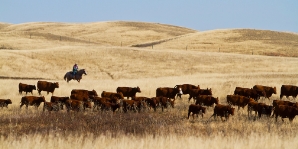Background
Background
The Matador Co-op Farm is located approximately 2 miles south and 6.5 miles east of Kyle, Saskatchewan, Canada. It was originally part of the Matador Ranch and is located along the south escarpment of the Missouri Coteau. The hills are very steep and contain many alkali or stagnant sloughs. Because of the rolling nature of the land, the hills are not suitable for farming and had remained as a native prairie grass land. The hills are about 150 feet higher in elevation than the flat lands to the south where Matador is located.
The Beginning
Following the end of the Second World War in 1945, many veterans returned home with no jobs or other opportunities waiting for them. The federal and provincial governments were looking at various ways of providing gainful employment for the returning veterans. The Federal Government of Canada established a program to offer grants to veterans so that they could purchase farmland and go into farming. Under the Federal Veteran's Land Act, each veteran was entitled to a grant of $2,320.00. This money was to be used for purchasing farm land. At the same time, the newly elected Co-operative Commonwealth Federation (CCF) party, a left-wing Socialist party, was elected in 1944 in Saskatchewan. They saw this as an opportunity to introduce their vision of co-operative farming.
Co-operative farms were agriculture settlements whose land and assets were owned and worked co-operatively. The co-op farm concept rejected private property and the single-family farming unit in favour of co-operative ownership and lifestyle. When the CCF was elected in 1944, they immediately embarked on a program of creating government operated businesses and enterprises. They also wanted to establish co-operative farms as a new way of life for Saskatchewan farmers.
The CCF fostered the establishment of co-operative farm communities, which were to be harbingers of a new socialist lifestyle. In some cases, established farmlands were pooled by farmers attracted by the idea, while in others, virgin land was given (by lease or purchase) to returning war veterans. These veterans built new communities where none had existed. Beginning in 1945, the new CCF government offered assistance in the form of Crown lands, operational loans, and technical advice to those who were willing to farm co-operatively. Among the target groups were Saskatchewan war veterans, for whom it was hoped the co-op farms would provide resettlement opportunities.
In the winter of 1945 the Government of Saskatchewan made available the first tract of provincially owned land for veteran’s co-op farms. This land was located on the old Matador Ranch which is just east of Kyle, Saskatchewan. Future members of the Matador Cooperative Farm attended a conference in Regina early in 1946. There were approximately 50 men in attendance at this first meeting. Each veteran was entitled to 480 acres of land. Many of those in attendance did not agree with the idea of co-operative farming or were not interested and only about 20 were ready to commit to the idea.
The veterans had been granted 10,000 acres (about 16 sections) of prairie grass land by the Saskatchewan Government. However, the Veterans Land Act did not allow the federal grant of $2,320 per veteran to be pooled cooperatively. The provincial government stepped in and made up for the lack of funds from the federal government with its own funding repayable at 3% interest. Veterans were given a thirty-three-year lease on the property with the option to purchase after ten years. Rent was payable at the rate of 1/7 of the value of the crop for each year. At this time, there were 19 men committed to the Matador Co-op Farm. The seventeen members had a total of about $40,000 in capital to work with. In 1948 the federal government relented and provided the veterans with their grants. This allowed the veterans to repay the provincial government.
The provincial government agreed to supply the equipment, tractors, trucks and materials necessary to get started and the veterans in turn, agreed to reimburse the government for all expenses incurred until such time as they acquired their own equipment.
There were still obstacles to overcome. Initially, the Wheat Board would only provide one permit book to the Matador farm instead of allowing one permit book for each farmer. The taxation department insisted on taxing the farm as a corporation, with the result that more income tax was owed than would have been if each member of the co-operative farm filed as an individual. Despite these problems the Matador Co-operative farmers overcame the obstacles, diversified their agricultural base and ran a very successful operation, including grain, cattle, sheep, chickens and turkeys. Despite a couple of crop failures in the early years due to hail and drought, Matador was soon producing large quantities of high-quality grain, so much, in fact, that the farm was unable to either market it or store it when the quota system was introduced in 1950. As a result, the Matador diversified into livestock, a move made easier by the large pool of labour available on a co-operatively run farm. For a number of years Matador was a thriving community, with its own school and co-operative store. At it's peak, the Matador had a population of about 63.
Changes occurred in membership over the years. Two of the original members were asked to leave in the first year. Their behavior did meet the ethical and moral standards as set up by group. That left 15 active members. Two new members joined Matador shortly after, bring the total back to 17. As single men married and began to raise families, they had houses built for them with garden spaces. Conditions continued to improve on the Matador. Then, in 1956, things started to unravel for the co-operative farm movement. In 1956, the right-to-purchase clause in the original leases kicked in and the farm faced its first major internal crisis. Two members left the co-op in 1957, taking their houses and families to the neighbouring village of Kyle. Although this loss was partially made up for by new members, the general decline in co-op farming became apparent. Three more members left before 1960. The decline was already established in the other co-operative farms as well. By 1974, thirteen of the original members had left.
As original members aged and were ready to retire, many of the cooperative farms were sold or the members began farming individually. The Matador Co-operative Farm Association faced the problem of how to pass on a very expensive operation to the next generation. Their solution was to negotiate with Allan Blakeney's Government (the New Democratic Party or NDP, a modernized version of the CCF) to change the provisions of the Land Bank Act. Changes were made to allow the Matador Farm to be sold to the Land Bank (Province of Saskatchewan) in 1974. This allowed the original members to receive their equity and to retire. It also allowed the second generation to continue to farm the land as the Matador Farm Pool. Under this program, the younger generation incorporated an entity called the Matador Farm Pool, leasing the original 10,000 acres of Matador land from the Land Bank. At the time, only about twenty-five people were left at Matador, but the transfer brought in another twenty. Together, they carried the co-operative farming tradition into the 21st century. In 1999, the group amalgamated with a Saskatchewan numbered corporation to become the Matador Farming Pool Limited. By 2004, the Matador only had eight members. Their families were still living on the original site and engaged in the same general farm activities that took place on the Matador since its inception in 1946. The Matador Farming Pool concentrated on grain and cattle production, which included two seed-cleaning plants. In addition to the eight members and their families, the farm supported eight full-time and three part-time employees.
The Matador Farming Pool operated until 2011 at which time the remaining members sold the farm to private interests and thus ends the story of the Matador Co-op Farm.

